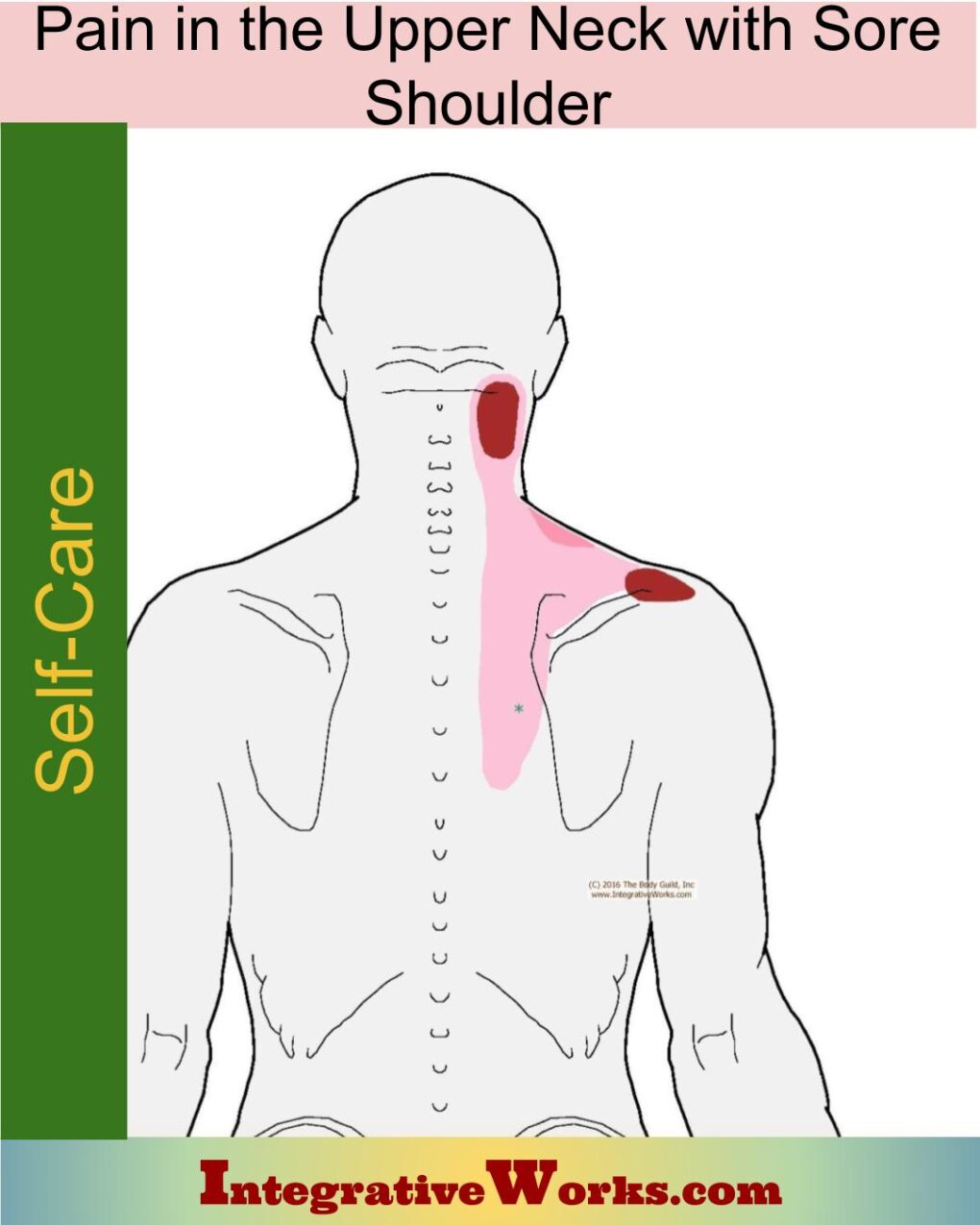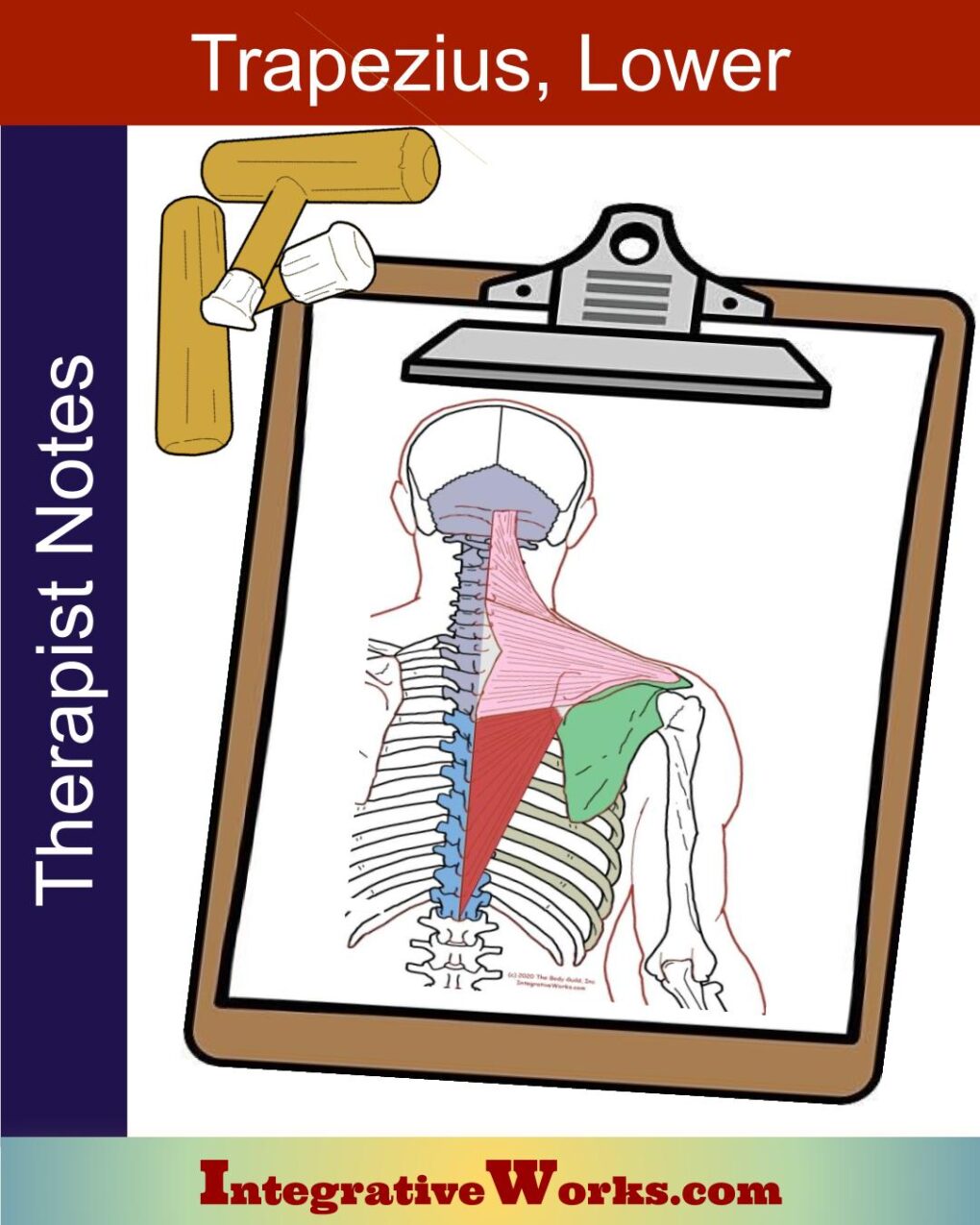Table of Contents
- How People Describe This Pain Pattern
- How You Activate and Intensify This Pain Pattern
- Self-Care – Getting Relief on Your Own
- Musculoskeletal Anatomy Behind Your Pain
- Therapy Notes for Massage and Bodywork
How People Describe This Pain Pattern

People often complain of pain in the upper neck with soreness on the top of the shoulder. Often, they are more focused on the pain in the upper neck than the top of their shoulder. Many patterns create pain and tension at the top of the neck. This referral pattern is not among the most common patterns that refer to the upper neck. However, when it becomes chronic the whole shoulder becomes achy.
Sensitive to Strap
The soreness on top of the shoulder is usually less bothersome than the neck pain. They will often rub it and say that it is tender when they press on it. It is mentioned more often when they carry a handbag or backpack that presses onto the sore spot.
Chronic Combination
People often describe the upper back referral as tension. Conversely, they refer to the spot at the top of the shoulder soreness. This pattern can create a focus of deep, achy soreness near the base of the neck. This combination of pain in the upper neck, aching near the base of the neck, and soreness at the tip of the shoulder can lead to chronic aching. Commonly, this leaves the person irritated and exhausted. Moreover, it creates an underlying tension that diminishes their quality of life. The background pain shortens their tolerance for tedium.
Irritability
People may start out describing this as stiffness in the neck. When asked for more details, they actually talk about the constant ache. When asked for more details, the “stiffness” seems to be more of the inability to find a comfortable position.
How You Activate and Intensify This Pain Pattern
/cdn.vox-cdn.com/uploads/chorus_image/image/63719069/1140594611.jpg.0.jpg)
Seated Problems
This upper neck pain with a sore shoulder can feed on itself and become quite chronic when people change their posture to avoid aggravating it on the back of the chair. This muscle is more active in stabilizing the shoulder blade against tension rather than pull it back. Leaning forward activates the trigger point to create a good stretch feeling.
One client suffered chronically from this trigger point. Daily, he was a negotiator who would tighten his chest and lean onto his elbows at the conference table. Releasing this trigger point directly only offered temporary relief. We had to balance the muscle tension between his chest and back. With regular stretching and bodywork and to open his chest, we were able to get lasting relief.
People find that this tight band of muscle is very tender when a seat digs into the mid-back. When a cold stadium seat chills the muscle, the neck and shoulder pain is worse.
The combination of these alternating postures can aggravate this trigger point. Leaning forward feels like a good stretch but weakens the muscle. Leaning into the chair activates the pattern with pressure.
Pulling the Shoulder
Often, this trigger point activates when the arm is jerked forward, as when you’re holding the leash of a dog that sees a squirrel. However, several muscles can get aggravated by a jerk forward. When the muscles around the shoulder joint are strong, this trigger point gets irritated as the muscle tries to stabilize the shoulder blade.
The Musculoskeletal Anatomy Behind Your Pain
Musculoskeletal Anatomy
This post on anatomy contains standard information about the origin, insertion, function, and innervation of muscles. Additionally, it includes information on functional considerations and anomalies.
Find Related Posts
Anatomy posts have a grid of all related posts. This includes posts on pain patterns, self-care, therapy notes, NMT protocols, cranial techniques, and cases.
Getting Relief on Your Own
Clinically Proven
Self-Care Strategies
Self-Care Posts have common sections to make them easy to follow and understand:
- Activities to Avoid or Change
- Strategies for Quick Relief
- Stretches and Exercise for Longer-Lasting Relief
- Yoga Corner
Therapy Notes for Massage and Bodywork
Better Bodywork
Through Shared Expertise
Therapy Notes provide details for cranial, spinal, and local joint work. These notes also link to a traditional neuromuscular protocol.
By treating integrative components first, direct work on the muscle becomes less intense while providing longer-lasting relief.
Support Integrative Works to
stay independent
and produce great content.
You can subscribe to our community on Patreon. You will get links to free content and access to exclusive content not seen on this site. In addition, we will be posting anatomy illustrations, treatment notes, and sections from our manuals not found on this site. Thank you so much for being so supportive.
Cranio Cradle Cup
This mug has classic, colorful illustrations of the craniosacral system and vault hold #3. It makes a great gift and conversation piece.
Tony Preston has a practice in Atlanta, Georgia, where he sees clients. He has written materials and instructed classes since the mid-90s. This includes anatomy, trigger points, cranial, and neuromuscular.
Question? Comment? Typo?
integrativeworks@gmail.com
Follow us on Instagram

*This site is undergoing significant changes. We are reformatting and expanding the posts to make them easier to read. The result will also be more accessible and include more patterns with better self-care. Meanwhile, there may be formatting, content presentation, and readability inconsistencies. Until we get older posts updated, please excuse our mess.





Comments are closed.